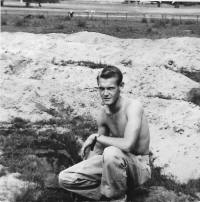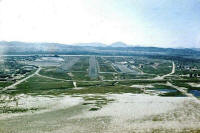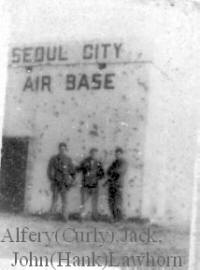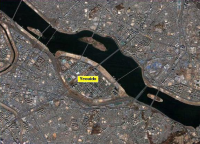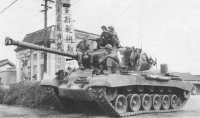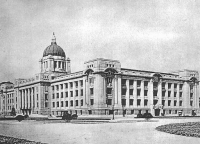|
We need your help to keep the KWE online. This website
runs on outdated technology. We need to migrate this website to a modern
platform, which also will be easier to navigate and maintain. If you value this resource and want to honor our veterans by keeping their stories online
in the future, please donate now.
For more information, click here.
|
|||||||||||||||||||||||||||||
 |
|||||||||||||||||||||||||||||
| Back to "Memoirs" Index page | |||||||||||||||||||||||||||||
Jack HarnedBuellton, CA "That afternoon I took a walk to the runway and went out into the brushy area. What a shock to see two bodies! I don’t know if they were North or South Koreans or even Chinese. I knelt down and said “I’m sorry”. It was the best I could do for praying." - Jack Harned
|
|||||||||||||||||||||||||||||
Memoir Contents:My MASH kind of storyIn May or June of 1951. I was in Korea on a little island in the Han River across from Seoul. Its designation was K-16. The Korean name was Yeouido, which means "the land nobody wants." Incident oneAfter setting up tents and digging a trench (known as a foxhole), we were free to roam around. “We” were me, John (Hank) Lawhorn, Alfery (Curley), and a third friend whose name I can’t remember. They were all radio guys. I don’t know how I got to be friends with them since I was a telephone installer/repairman. We were all in the 6160th Communication Squadron. Our first walk around took us to the entrance of the base. That afternoon I took a walk to the runway and went out into the brushy area. What a shock to see two bodies! I don’t know if they were North or South Koreans or even Chinese. I knelt down and said, “I’m sorry.” It was the best I could do for praying. Same subject attached to the Seoul City Air Base picture above. Just in front of us was a tributary of the Han River and the bank there had five or six bodies. On a website I found this picture. The caption said: “During the fighting”. Was it the same two I saw at the end of the air strip? I guess I’ll never know unless someone else that was there that March/April 1951 can assist in research. Look at the pock marks on the building. This is the island today. It is the most expensive land in Korea now--sometimes called Korea’s Wall Street! Incident 2 and follow-upIn the military, units were moved and members were changed quite often, so after 50 years or so not too many names or faces focus. One name I almost remember was Strauss. He was from New York, I think. We were talking about something or other, like learning to drive, and the subject of accidents came up. I do remember him telling about his accident, saying that when he woke up he was still in the car and all he could see was his girlfriend's panties in the windshield. Part twoWe had an alert about 2 a.m. one morning. Well, actually two mornings, but this is the second one. There were sandbags stacked around the main buildings and the telephone/supply building was one of them. We were all kneeling behind them when an airplane went over and the searchlights caught it. All of a sudden big guns let go. I don’t know when the tank moved in earlier, but it fired a few times. It was loud and the concussion was felt. Then I felt someone squeezing my ankle. It was Strauss. I tried to hit his hand away. I was quite calm and taking in the event--or just too naïve to know this was serious stuff. I remember looking at the tank the next morning and it had a really long barrel. Oh, the plane was one of ours. Glad the tank (and others) missed. While we are on the subject (this is more of a MASH connection), the other incident occurred when we were pulled out of bed (cots, but good, too) because we had a “Bed-check Charlie” come over. It was a single engine plane (the motor was like a bi-plane) and we could see the outline. We were told not to fire. The plane went on and a few minutes later an explosion was way off (maybe a half mile) on a hill. Glad he missed too! Promotion boardI was a sergeant in May 1951. We lived in tents during this period, but part of the time we followed Air Force protocol. This required promotion reviews, so we had one. The board of reviewing officers had one officer and two enlisted men. I don't remember who they were, but I can guess. It was evening and fairly dark. The review board had a table at the end of the tent and I was seated on an up-ended box in front of them. They asked me some general Air Force-type questions and a few about my duties, which included installing and operating telephone communications--a switchboard and field telephones. There was some movement behind me and then a hand came over my right shoulder. A voice said, "Care for a beer, Sergeant?" Yes, that was Colonel Hess, just back from a mission. You don’t know Colonel Hess? You may check a movie named “Battle Hymn” to find more almost accurate information about the 6164th unit. I remember First Sergeant Herman. In the book (also named “Battle Hymn”), I found the name of Cpl. Tom Cabaniss. We exchanged memories by e-mail a couple times. These were part of the e-mails we shared. Building F-51 Revetments, May of 1951When we first moved up to K-16, we didn't have much equipment to install so we were put to duties for living and protection. My job was to drive a jeep and trailer to the end of the island and get loads of sand. Koreans would then fill bags with the sand and stack them around the F-51 Mustangs. Digging a trench was one of the jobs. One of the pictures shows me kneeling next to it. We had to get into the trench once, but no enemy showed up. Behind me you can see C-46's--or their wheels, at least. One of their jobs was to drop surrender leaflets. I have copies of a few of those. I exchanged a message with an ex-serviceman in that outfit who used the e-mail name of QBOAT. Belly landing, summer of 1951I think this incident was my second assignment to K-16. We had Quonset huts then. Anyway, I was on the switchboard and messages were coming through that said a plane needed to abort the mission on the field. I got away long enough to see it come in and slide off the end of the runway. It was a bomber that seemed to be a B-29, but I am not sure. My most vivid memory is that a bunch of guys were running toward the plane to help and the crew all got out and were running away from the plane. I had to get back to my duty so didn't see anything more. I thought I could see it in the morning, but no, it was gone already! I know this happened because we had to replace the telephone cables that were buried at the end of the runway. The runway was made of the metal plates with the holes. Court Martial threatOne evening I was on the switchboard. (Sidelight: We had Korean girls to operate the switchboard during the day. Back to that in a minute.) A helicopter was in trouble some distance away. A call came in that wanted to be connected to the control tower, but I refused because my Major had given orders to not pass any calls to the control tower. I offered to patch the Lieutenant into the Major, but the offer was refused. I never heard any more about it. I guess a Major trumps a Lieutenant! About the Korean operators. One evening I had to take a jeep to pick up cables or something, so I gave the girls a ride home. Home was just a shack on the side of a hill. Seoul was the largest city in Korea (the capital) and Yong Dong Po wasn’t very large. I now suspect they were from Seoul. (They spoke quite good English--maybe they were college students until June 1950. The point is that I now think they would be called refugees. I had driven through Seoul and it looked like a ghost city. Another sidelight: I went to the rear of the capitol building (named The Blue House) to pick up cable one afternoon. I was alert or paranoid, but I had to straddle a manhole in the middle of the street. I thought the cover was missing and set as a booby trap. I’ll never know. On the same trip I was stopped by MP’s. Why? They said I wasn’t supposed to be smoking. If there were cell phones then, I might have gotten that Court Martial. |
|||||||||||||||||||||||||||||
Photo Gallery(Click a picture for a larger view) |
|||||||||||||||||||||||||||||
|
|
|||||||||||||||||||||||||||||
|
|||||||||||||||||||||||||||||
 |
|||||||||||||||||||||||||||||


